Conservation and Diaspora
Air Date: Week of October 17, 2008
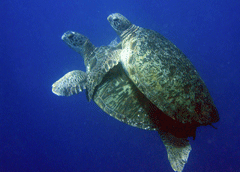
Two green sea turtles mating. The new Phoenix Islands Protected Area will provide an important habitat reserve green sea turtles, whose populations in the Pacific are in dramatic decline. (Courtesy of the New England Aquarium)
The Pacific island nation Kiribati (Kir-uh-bahs) may soon become one of the first casualties of climate change. Rising sea levels due to warming temperatures are already having effects on the small island. But that hasn’t stopped the country from setting aside some of their pristine waters for conservation. Host Steve Curwood speaks with President Anote (ah-no-tay) Tong of the Republic of Kiribati and Dr. Greg Stone, vice president of Global Marine Programs at the New England Aquarium, about the Phoenix Islands Protected Area
Transcript
[MUSIC: Kiribati: All music is taken from the film Paradise Found: The Phoenix Islands produced by The New England Aquarium (2005)]
CURWOOD: The Phoenix Islands in the South Pacific occupy one of the most remote spots on Earth. It’s takes five days by boat to get there from the capital of Kiribati, to whom they belong, and for conservationists, that’s a good thing. These low-lying coral atolls are the centerpieces of what is now the world’s largest marine preserve, covering more than 73,000 square miles.

The Phoenix Islands. (Courtesy of phoenixislands.org)
CURWOOD: Certainly a paradise for Greg Stone. He’s a senior scientist and vice president of the New England Aquarium in Boston. Shortly after he first explored the Phoenix Islands back in the year 2000, he set about trying to protect the region. Part of his effort included helping to produce a film documenting these immense tracts of virgin coral reef.
Just as intact tropical rainforests house many terrestrial species, archipelagos of healthy tropical corals – organisms themselves – nurture prodigious amounts of marine life. And thanks to their remoteness and some favorable ocean currents, the Phoenix Islands have so far escaped the over fishing and warming oceans that have trashed many of the world’s coral reefs. During a recent visit to the Aquarium, Greg Stone took me by a tank filled with colorful fish – with a sign, “Phoenix Islands, Protecting Paradise”.
[SOUND OF AQUARIUM, KIDS LAUGHING]
STONE: The first thing you see is Nikumaroro, which is the first island I visited there. And then we see some beautiful pictures of the Napoleon Wrasse, which is one of the most valuable and endangered fish in the world and the Phoenix Islands has more of those than anywhere else in the world.
CURWOOD: I’m looking at a fish that looks like it’s kind of wearing brain coral on top of its head, and it almost has some sort of hairdo, like a really fixed bob cut or something.
STONE: And big lips.
CURWOOD: I don’t think that was done with augmentation, though.
STONE: No, I think this is the real thing. Actually, what happens is these fish are caught; and one fish can be worth five or ten thousand dollars.
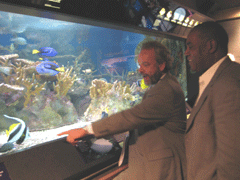
Dr. Stone shows host Living on Earth Steve Curwood an angelfish, a species native to the Phoenix Islands.
CURWOOD: And here we have a tank. What fish that we see in this tank here could we find in the Phoenix Islands?
STONE: Ah, almost all of them. This is our Pacific reef tank, and we’ve got a surgeonfish, we’ve got a beautiful angelfish that’s black and white, with sort of a feathery fin that comes off the top and a yellow tail. It’s sort of a kaleidoscope of colors, almost like a Jackson Pollock painting, going on here. And this actually is not a bad representation of the Phoenix Islands because you know, we’re an aquarium so we artificially stock it higher than most reefs in the world, but this density, we’re looking at probably 150 fish in one glance – that’s kind of what the Phoenix Islands are like. It’s the way the oceans are supposed to be.
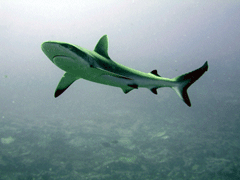
The shallow, remote coral reef systems of the Phoenix Islands provide an ideal shark nursery ground. (Courtesy of the New England Aquarium)
CURWOOD: The President of Kiribati, Anote Tong, was visiting the aquarium that day. The leader of 100,000 citizens living on 300 square miles of land, President Tong also administers more than a million square miles of ocean. As we started talking with Greg Stone, President Tong recalled life as a child in the islands.
TONG: We used to run after the fish, sometimes we’d get stung by many things, as small kids do, we’d get coral in our feet, but I think what is really brought home here is our ability to coexist with the marine ecology. And over the years of diving that I’ve been doing in the last 20 years I have seen changes, and so seeing what was the position in the Phoenix Islands, it was so necessary that we look after this. It has been bestowed to us, an endowment given by God – we didn’t get much else, so we thought it was necessary that we look after this.
CURWOOD: So Doctor Stone, go back to the moment that you first laid eyes on the Kirabati and the Phoenix Islands. What was that like?
STONE: We came over the horizon in a boat out of Fiji and we came up on an island called Nikumaroro, which is my favorite of all the Phoenix Islands. It’s a beautiful, beautiful island.
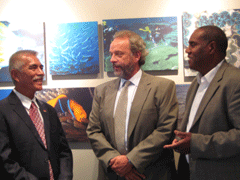
Anote Tong, Dr. Greg Stone, and Steve Curwood at the New England Aquarium.
CURWOOD: President Tong, let me turn to you. If fishing is the way people survive subsistence, and I imagine there’s some commercial interest there as well – if you make this whole area a conservation reserve, what happens to incomes locally?
TONG: I think what has to be understood is the Phoenix Islands are well away from the major population centers, so there is not that significant impact on the earning capacity of our local fishermen.
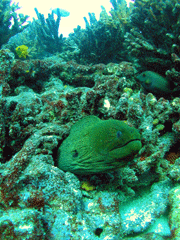
A green moray eel emerges from reef in Phoenix Islands. (Courtesy of the New England Aquarium)
CURWOOD: Obviously with some of the “big fish” there, it will upset people who have been using the area, I imagine South Korea has been fairly active there, perhaps Japan as well?
TONG: Yeah, you’re quite correct. The Koreans, the Japanese are not very happy – but I think this is where the question of compensation for that loss will be discussed.
CURWOOD: Greg Stone, from your side, you’ve been working with donors here in the U.S. to make it possible. How will this work, in your view?
STONE: The way it works is Kiribati allows foreign countries to come in and fish, and foreign countries pay Kiribati a licensing fee for that access. And we are analyzing exactly what those fees are for the area, the Phoenix Islands protected area, and then establishing an endowment that will pay Kiribati the lost revenues. So the fish stay in the ocean, Kiribati still gets its money, and everything works out.
CURWOOD: What about enforcement? Some of these fish, especially the big fish, are worth a lot of money. There may be rules that don’t permit the taking of them, but people may not respect those rules.

Two green sea turtles mating. The new Phoenix Islands Protected Area will provide an important habitat reserve green sea turtles, whose populations in the Pacific are in dramatic decline. (Courtesy of the New England Aquarium)
CURWOOD: President Tong, I want to talk to you about the changing oceans and climate change. A combination of the more acidified and toxified ocean and changing climate patterns really are killing off some of these coral reefs around the planet, and they’re also a threat to your nation. As projected sea level rises, so shrinks Kiribati.
TONG: From our own point of view, as people living in low-lying island countries, we’ve come to experience new phenomena. There are things that are happening now that did not happen in the past. There are villages which have been there over a century, and they’ve had to relocate. This poses unimaginable consequences for us, and we’ve raised that even at the United Nations General Assembly, and unfortunately have not had much interest, until recently. The ability of the islands to support plant and animal life will be significantly reduced, until eventually perhaps to the point when they will be totally uninhabitable. So the question arises, what do we do? Well obviously we cannot swim for the rest of the millennium, so we have to relocate, unfortunately we have to look at that option, undesirable as it may seem. And perhaps the sacrifice that we are making in terms of giving up part of our marine area, perhaps some countries will also make the sacrifice to give us some of their land area where we can survive as a community, as a nation, as a people. And we are hoping that the international community will be able to respond to this, one of the most serious moral challenges facing humanity at this point in time.
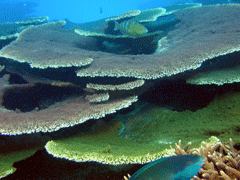
Table corals that take decades to form and are easily destroyed by commercial fishing activity. (Courtesy of the New England Aquarium)
[MUSIC: Kiribati: All music is taken from the film Paradise Found: The Phoenix Islands produced by The New England Aquarium (2005)]
CURWOOD: A familiar church song on Kiribati speaks to the courage it takes to journey out on the vast ocean where there are only little specks of land. Now, with sea levels rising, the people of Kiribati must prepare for a journey from which they cannot hope to return to their own land. But they can hope that their marine paradise will be protected forever.
[MUSIC: Kiribati: All music is taken from the film Paradise Found: The Phoenix Islands produced by The New England Aquarium (2005)]
To see pictures and film from the Phoenix Islands, go to our website, loe.org. Ashley Ahearn produced our segment on Kiribati.
[MUSIC: Kiribati: All music is taken from the film Paradise Found: The Phoenix Islands produced by The New England Aquarium (2005)]
CURWOOD: Coming up, the ecovillage that’s remaking the dry grasslands of Colombia. Keep your ear to the ground. It’s Living on Earth.
ANNOUNCER: Support for the Environmental Health Desk at Living on Earth comes from the Cedar Tree Foundation. Support also comes from the Richard and Rhoda Goldman fund for coverage of population and the environment. And from Gilman Ordway for coverage of conservation and environmental change. This is Living on Earth on PRI, Public Radio International.
Links
Living on Earth wants to hear from you!
Living on Earth
62 Calef Highway, Suite 212
Lee, NH 03861
Telephone: 617-287-4121
E-mail: comments@loe.org
Newsletter [Click here]
Donate to Living on Earth!
Living on Earth is an independent media program and relies entirely on contributions from listeners and institutions supporting public service. Please donate now to preserve an independent environmental voice.
NewsletterLiving on Earth offers a weekly delivery of the show's rundown to your mailbox. Sign up for our newsletter today!
 Sailors For The Sea: Be the change you want to sea.
Sailors For The Sea: Be the change you want to sea.
 The Grantham Foundation for the Protection of the Environment: Committed to protecting and improving the health of the global environment.
The Grantham Foundation for the Protection of the Environment: Committed to protecting and improving the health of the global environment.
 Contribute to Living on Earth and receive, as our gift to you, an archival print of one of Mark Seth Lender's extraordinary wildlife photographs. Follow the link to see Mark's current collection of photographs.
Contribute to Living on Earth and receive, as our gift to you, an archival print of one of Mark Seth Lender's extraordinary wildlife photographs. Follow the link to see Mark's current collection of photographs.
 Buy a signed copy of Mark Seth Lender's book Smeagull the Seagull & support Living on Earth
Buy a signed copy of Mark Seth Lender's book Smeagull the Seagull & support Living on Earth

